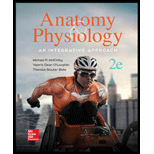
Introduction:
Nasal septum divides the nasal cavity into right and left halves and it creates the two nostrils. It divides the nose into two nostrils. The depressor septi nasi muscle depresses the nasal septum. The external fleshy end of the nasal septa is referred as the columella.
Answer to Problem 1DYKB
Correct answer:
Nasal septum is formed by two bones; vomer and perpendicular plate of the ethmoid bone. Therefore, option a. is correct.
Explanation of Solution
Reason for the correct statement:
Option a. is given as “perpendicular plate of the ethmoid bone and vomer”. Nasal septum contains hyaline cartilage and bone. The nasal septum is made up of five structures. These structures include vomer bone, perpendicular plate of ethmoid bone, septal nasal cartilage, crest of maxillary and palatine bone. Hence, the two bones that form the nasal septum are vomer and perpendicular plate of ethmoid bone.
Hence, option a. is correct.
Reasons for the incorrect statements:
Option b. is given as “perpendicular plate of the ethmoid bone only”. Nasal septum is also formed from vomer bone. Hence, option b. is incorrect.
Option c. is given as “nasal bones and perpendicular plate of the ethmoid bone”. There are no nasal bones in nasal septum. Hence, option c. is incorrect.
Option d. is given as “vomer and sphenoid bones”. Sphenoid bones do not form the nasal septum. Hence, option d. is incorrect.
Hence, options b., c., and d. are incorrect.
The nasal septum is made up of vomer bone, perpendicular plate of ethmoid bone, septal nasal cartilage, crest of maxillary and palatine bone.
Want to see more full solutions like this?
Chapter 8 Solutions
Anatomy & Physiology: An Integrative Approach
- The lumbar puncture must be done below the a. first lumbar vertebrae. b. second lumbar vertebrae. c. third lumbar vertebrae. d. sacrum.arrow_forwardThe nasal septum is composed partly of the same bone as:- a. the zygomatic arch. b. the hard palate. c. the cribriform plate. d. the nasal concha. e. the centrum.arrow_forwardWhich of these statements concerning ribs is correct?a. The true ribs attach directly to the sternum with costal cartilage.b. There are five pairs of floating ribs.c. The head of the rib attaches to the transverse process of thevertebra.d. Ribs 8–10 are classified as true ribs.e. Floating ribs do not attach to vertebrae.arrow_forward
- Foramen of the Cranial BonesWrite the letter of the structure that passes through each the foramen/canal/meatus listed.1.Superiororbital fissurea. a.Supraorbital nerve (br. of CNV) and supraorbital artery 2. Optic canal b. Cranial nerves IX, X, XI and internal jugular vein 3. Foramen lacerum c. Sound waves 4.Foramen rotundum d. Internal carotid artery 5. Foramen ovale e. Hypoglossal nerve (CN XII) 6.Supraorbital foramen f. Small arteries, normally covered by cartilage 7.External acousticmeatus g. Facial nerve (CN VII) 8. Stylomastoid foramen h. Vestibulocochlear nerve (CN VIII) and facial nerve (CN VII) 9.Foramen spinosum i. Optic nerve (CN II) 10. Olfactory foramina j. Meningeal vessels (supply blood to…arrow_forwardThe paranasal cavities open into the nasal cavity. They include which of the following? a. frontal sinuses b. maxillary sinuses c. ethmoid cells (sinuses) d. sphenoid sinusarrow_forwardThe perpendicular plate of the ethmoid and the formthe nasal septum.a. palatine process of the maxilla c. vomer e. lacrimal boneb. horizontal plate of the palatine d. nasal bonearrow_forward
- Mark the following statements as true or false. If a statement is false, correct it to make a true statement. a. The four paranasal sinuses are the frontal, parietal, sphenoidal, and mandibular sinuses. b. The cribriform plate is a component of the ethmoid bone. c. The sella turcica of the sphenoid bone houses the pituitary gland. d. The styloid process of the temporal bone is a thick, posterior projection. e. The most conspicuous feature of the temporal bone is the foramen magnum.arrow_forwardThe ligament that helps to maintain the alignment of thecondyles between the femur and tibia and to limit the anteriormovement of the tibia on the femur is thea. tibial collateral ligament.b. posterior cruciate ligament.c. anterior cruciate ligament.d. fibular collateral ligament.arrow_forwardThe site of the sella turcica is thea. sphenoid bone. c. frontal bone. e. temporal bone.b. maxillae. d. ethmoid bone.arrow_forward
- The costal margin is the inferior edge of thea. sternum.b. clavicle.c. rib cage.d. linea albaarrow_forwardThe mandible articulates with the skull at thea. styloid process. c. mandibular fossa. e. medial pterygoid.b. occipital condyle. d. zygomatic archarrow_forwardThe ischial spine is found between which of thefollowing structures?a. inferior pubic ramus and ischial ramusb. pectineal line and arcuate linec. lesser sciatic notch and greater sciatic notchd. anterior superior iliac spine and posteriorsuperior iliac spinearrow_forward
 Medical Terminology for Health Professions, Spira...Health & NutritionISBN:9781305634350Author:Ann Ehrlich, Carol L. Schroeder, Laura Ehrlich, Katrina A. SchroederPublisher:Cengage Learning
Medical Terminology for Health Professions, Spira...Health & NutritionISBN:9781305634350Author:Ann Ehrlich, Carol L. Schroeder, Laura Ehrlich, Katrina A. SchroederPublisher:Cengage Learning
